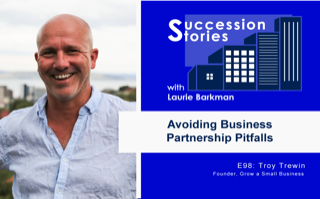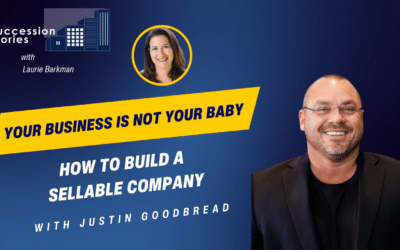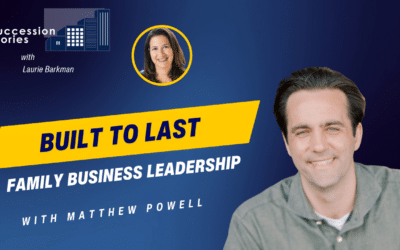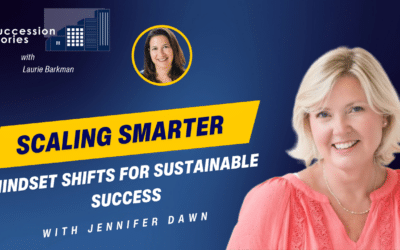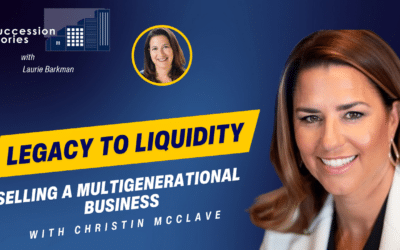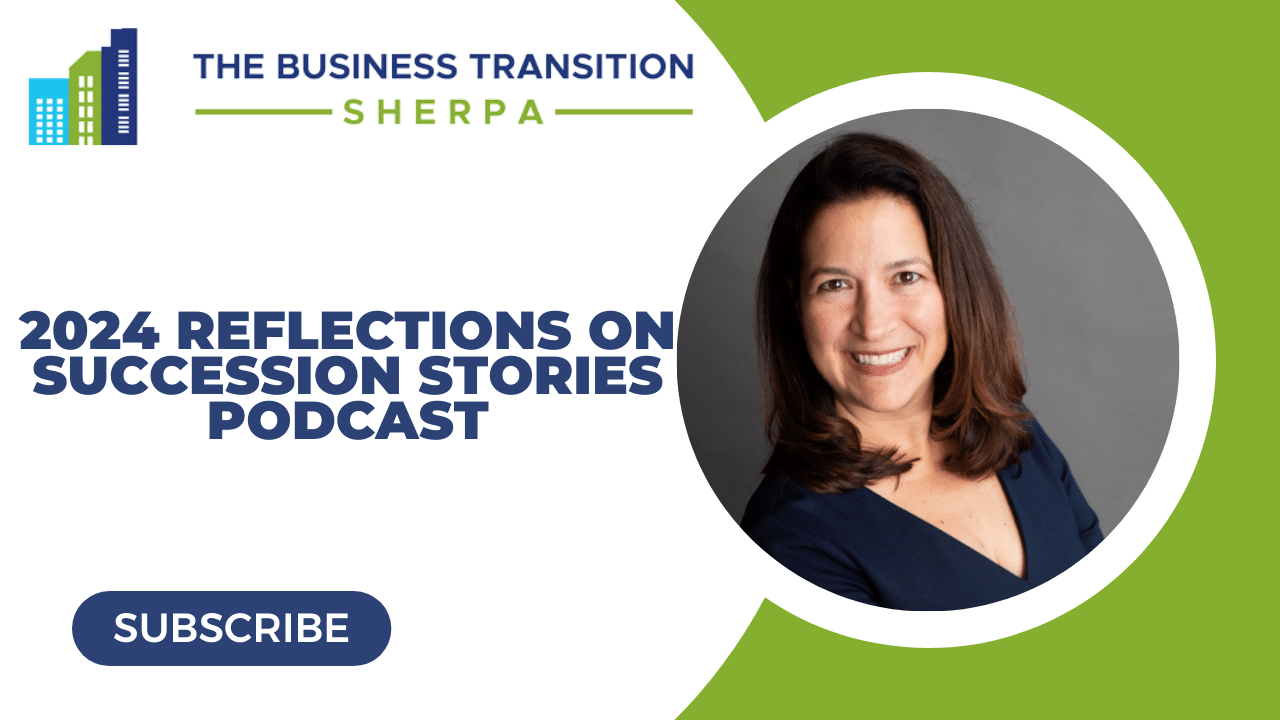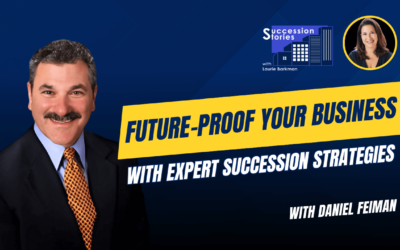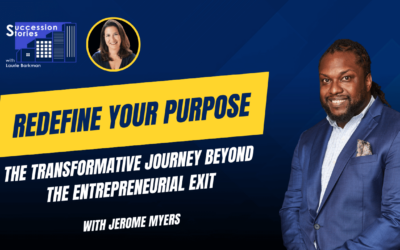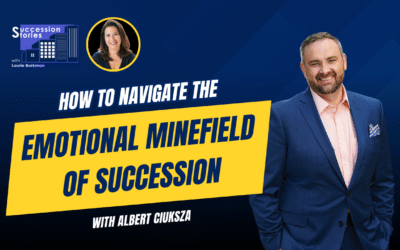What are the top pitfalls to avoid when choosing business partners? Australian business leader, Troy Trewin, joins Laurie Barkman to discuss finding the right fit, setting up a partnership for success, and having an exit door if things go sideways.
Troy has started, acquired, and grown 14 businesses working with 28 business partners in Australia, New Zealand and the United Kingdom in various industries including technology, spirits, and construction. He hosts the Grow a Small Business podcast and leads a business owner community in Australia.
Listen in to learn more about:
- Finding alignment between founders and partners to create value
- Importance of shared values and work ethic
- Shareholders agreements
- Role of board of advisors and good governance
Show links:
https://www.growasmallbusiness.com/
https://www.linkedin.com/in/troytrewin/
Don’t leave your exit to chance.
Stony Hill Advisors works with owners like you to get ready and maximize value when you’re ready to sell.
Visit www.stonyhilladvisors.com/podcast for a complimentary business valuation.
About Succession Stories Podcast
Succession Stories is an award-winning podcast hosted by Laurie Barkman, the Business Transition Sherpa– guiding business owners through the process from “transition to transaction.”
Learn more at https://thebusinesstransitionsherpa.com
Book a 1:1 Advisory call at:
We appreciate your support…subscribe, share, and post a review to share what you like about the show!
Transcript
Laurie Barkman:
Welcome to Succession Stories! I’m Laurie Barkman. As an exit value planning and M&A advisor, I call myself The Business Transition Sherpa. This podcast guides entrepreneurs from transition to transaction- from building value in your business to letting go.
What do I do when I’m not hosting a podcast? I work with owners to maximize business value with my firm, SmallDotBig. And as a Certified Mergers and Acquisitions Advisor with Stony Hill, I guide you through the complex process of selling your company.
Tune-in to Succession Stories for weekly insights to reward your hard work and avoid succession regrets. Hit subscribe wherever you listen to podcasts, and sign-up for our newsletter at successionstories.com. Here’s to your success!
Is this the year to sell your company? Don’t leave your exit to chance. Stony Hill Advisors works with entrepreneurs like you to get ready for what may be the biggest transaction of your life. Learn what your business is worth by visiting stonyhilladvisors.com/podcast.
Intro:
Troy Trewin has started, acquired, and grown 14 businesses working with 28 business partners in Australia, New Zealand and the United Kingdom in various industries including technology, spirits, and construction. In 2004 Troy founded the Grow A Small Business community, which now has a weekly business podcast, and monthly meet-ups of business owners in Australia. Currently Troy Chairs three of the five Boards he sits on and provides coaching to a handful of CEOs and founders of fast-growing businesses in various sectors. I enjoyed this discussion because it puts a spotlight on something we might take for granted as easy. Choosing a business partner. I think Troy shares an important reality check for entrepreneurs who have business partners or are considering bringing on a partner – family or outside partner. It’s important to get the right people, whether they are shareholders working in the business or passive, establishing a board of advisors, and an exit door if things go wrong. Enjoy my conversation about avoiding business partnership pitfalls with Troy Trewin.
Laurie Barkman:
Troy Trewin it is a joy to be with you. We are talking to each other from literally the other side of the world. You are the first person to be on my show from Tasmania, which is a very, very cool thing to be talking with you. We met recently not too long ago because of your show and I was excited to be on your podcast. It’s a great show. You’ll talk more about it, I’m sure, and I want to encourage everyone to give it a listen and give your show a listen, so first off, let me welcome you to Succession Stories. I’m glad you’re here.
Troy Trewin:
Thanks, Laurie. I’m really looking forward to it, and particularly the topics we’re going to talk about today, choosing the right business partners and also touching on family businesses. I’ve got a bit of experience there, but just want to point out to the audience, Tasmania is a small island, just south of Melbourne in Australia, obviously Australia is a big island, but when I travel internationally, often, Tasmanians will introduce themselves from Tasmania, not from Australia and then people think we’re from Tanzania and not Australia, so we often get confused, where in the world we are, but it is definitely at the end of the day evening for you and early morning for me.
Laurie Barkman:
Yeah, it’s a very beautiful place, so if people aren’t familiar with that part of the world, I encourage them to take a look at YouTube and check out some videos and do some virtual travel. Let’s start with you. You are an entrepreneur through and through. You have extensive experience in starting companies, growing companies. Tell us a little bit about you and that journey.
Troy Trewin:
Started in business late 1999, so went to university, did two degrees. Got a Bachelor of Business majoring in Accounting and a Bachelor of computing and then worked for a big firm for three years straight out of uni. The only real job I’ve ever had, as I like to say, PriceWaterhouseCoopers, one of the biggest professional services firms in the world but I always knew that I wanted to run my own businesses. My parents grew a small fuel business into a medium sized distribution business. I’ve actually had my father on the podcast, and I learned a lot interviewing dad on the cast, didn’t realize he took as many risks, probably more risks than I’ve taken. He’s a very quiet person but so watching them do that, I guess, running a business was in my blood. My first lawn mowing… my sprayer, my first business was a lawn mowing business, I think when I was aged 12 and quite proudly last year, my then eight year old daughter asked when she started her first business selling lollies if she was the youngest in the family, and I said, “I have to check with pop because I was 12 and I’m pretty sure he was older than me, so yes, I think you’ve got the title for the youngest in the family.”
Laurie Barkman:
There is an entrepreneurial gene.
Troy Trewin:
I always knew that I wanted to run my own businesses, but I knew the value of working in a big large organization as well because I was going to learn from that but also having that friend as well. PricewaterhouseCoopers is well renowned, but it was really hard, Laurie right at the end, reaching to get out and start my own thing so in my typical style, I quit late 99 started two internet companies at once and was working 100 hour weeks sleeping under my desk. We were in the warehouse we had a gift retailer, Greek business partner in Melbourne that had two big warehouses, lovely Greek family, and getting like warehouse shops and I brought the online element to that and at the same time, as I like to analogize in the mining rushes around the world, most people made the money out of selling the pans or the pubs and you know, not actually panning for gold so I went panning for gold with the retailer as well as selling the shovels and the picks which was a web design development company which is still going and growing now. We’ve got offices in Melbourne, Sydney, Adelaide and Bali and from there we just kept starting or acquiring technology companies. We had a fruit and vegetable delivery business in Melbourne that we acquired, excuse me, that didn’t go so well. We’ve had a few failures along the way, had to shut a few down or sell them off and then move to London 2007 to a small IT support company with two business partners and grew that pretty quickly.
We got to about 20 team members in a bit over three years before I moved back to Australia and then got into the distilling industry, managed the New Zealand whisky collection from here from Tasmania, but I was in New Zealand every three months. A good friend of mine had found the last 443 barrels of New Zealand whiskey. Some of those were 30 years old. Excuse me. Which makes New Zealand only the fourth country in the world to have a 30 year old single malt. I ran that for about nine years, had a sabbatical for a couple of years to run a family business here in Tasmania, another distilling business the family sold out and the founder of that, Bill Lark, is known as the godfather of Australian whisky basically so they sold to some investors. I was the first CEO into that business, so I didn’t have any shares but I grew that for a couple of years, cleaned that business up and then went back to New Zealand whiskey and did a management buyout. That Lark distilling business is now listed on the ASX. It’s worth about a quarter of a billion dollars in market cap and that was a really interesting time, a couple of years managing that family business.
More recently, I’ve been working with other businesses, so I currently sit on five boards, I chair three of those boards. Last year, I finished up chairing another board, which is a family business, which I’d love to speak about in a moment so a few other businesses thrown in there, and yes, of course, we had you on our podcast, not long ago, which will be live by the time this is live and that was a great cast, and I really appreciate you coming on. Every twice a week we have a cast go live, talking with business owners that have experienced growing small business.
Laurie Barkman:
There’s so much experience that you have Troy, I mean, just to pick out a few things we because we only have so much time together but I know when we talked ahead of time, there were a couple of things that jumped out at me, that I thought would be really instructive for our audience, for my audience, and people listening who certainly could learn a lot from you on the growth of entrepreneurial, fast growing companies. One of the areas that I thought we could spend a little bit of time on is partnerships. I haven’t yet really dived into that with folks who have come on the show, some people have talked about co-founding with their spouse, others have siblings that are co-owners. I think in your experience, mostly these are people unrelated to you, correct?
Troy Trewin:
I’ve had 29 business partners, that’s not shareholders as business partners, but of working businesses with me across 15 businesses in three countries so yeah, I’ve seen a lot, Laurie. It’s been an interesting journey and if I could go back to day one and tell myself, there’s a lot I’d be sharing with myself about choosing the right business partners and also the other businesses I’ve managed not had equity in just seeing the wrong business partners there that can really destroy their business just go sideways so the five boards I sit on is a good example. I often write about this in my weekly leadership email, when I see examples in a business that is dysfunctional, because of the shareholder infighting compared to another board I sit on, where the shareholders are aligned with the founder and so it’s just so important to get that first piece of recruitment. Recruitment is the most important thing a manager does. I believe that first recruitment is getting the right business partners, whether they’re passive shareholders or active in the business getting that right, because that can really distract you from doing what adds value and creates wealth.
Laurie Barkman:
Maybe let’s just paint some scenarios. You have 29 business partners, they’re all different scenarios. If we were gonna describe them at a high level is one scenario where you’ve chosen and selected these business partners together, and from the very beginning, another scenario is maybe bringing in partners over some period of time after the business has been in operation and then maybe there’s a third scenario, help me understand just broad strokes.
Troy Trewin:
Well, firstly, I’d like to point out that a big part of this has been my development journey as well so I’m a much better person and manager of people and that includes business partners now than I was 23 years ago when I started so I’ve really learned. I’ve got a drive for continual learning, which I think all business owners need to have, but it’s also the emotional intelligence, the communication style, understanding people, but fundamentally, you’ve got to come back to getting those right people, they’ve got to have the right the same work ethic as you and the same values and that’s been a problem in some of these businesses. The work ethic hasn’t been there for some people and then if you can’t communicate about that issue in a professional way that can really fester and blow up and then the whole thing falls apart.
Specific examples, there was one family business I my brother and I helped my mother. The land we grew up on in country Victoria just north of Melbourne. We subdivided our block of land where we grew up so 27 blocks of land. That was really the first family businesses, it was my own family that I had to work with and Mum was quite a difficult person but she raised us quite well, both my brother and I are hard working, driven, my brother’s a plumber, but that was an interesting dynamic more around the family dynamics with our mother than it was the typical issues you get with I think in a family business my brother and I fighting, we got along really well. That’s one example I think.
If I can touch on choosing the right business partners, it’s, again, like recruitment, you’ve got to spend as much time with a potential business partner, before you can really assess, let your gut tell you is this the right fit for me and again, the work ethic, the value alignment is really, really important. Also, in all businesses, something I didn’t do early on, and a lot of businesses that I coach and work with haven’t done is make sure you’ve got a rock solid shareholders agreement in place, because that solidifies the understanding of all the people in the business. They’re investing their time or money, in case anything goes wrong, and again, it stops the distractions and the infighting.
Laurie Barkman:
Yeah, the fit is certainly a good thing for us to talk about here. When your business partners or your family, you don’t really have a choice, right, and that’s a tradition with your mom and your brother, now that maybe it was a good fit in some respects, and maybe not in others but you’ve didn’t have a choice. They were your business partners. In these other scenarios and the companies when you’ve gotten to choose who your business partners were, what were some of the things, you mentioned work ethic, you mentioned value alignment. Where did you find a disconnect?
Troy Trewin:
Sorry, would you ask that question again?
Laurie Barkman:
Did you find a disconnect with some of the business partners that you’ve had and the hindsight being 2020, when you can look back and say, “Wow, I really made a bad choice”, you don’t have to name names, of course, we’ll protect the innocent, but looking back, and you’d say, if I could do it over again, I wouldn’t have chose this person or that person.
Troy Trewin:
I think again, my one good example is a business partner that I just, over time kind of fell out with, because I just didn’t like some of the things, the small things he did and said that just irked me, and really were against my own personal values. Over time that built up and this is early on in my career, business career, so I wasn’t, I guess, equipped with emotional intelligence, or the communication tools to be able to work through those issues, probably, fundamentally, this person just wasn’t on the same page as I was.Again, doing as much research about a person, spend time with them socially as well, to make sure that your gut’s telling you that this is something you can work with.
There’s a great example I spoke about on our podcast a couple of times where a CEO of a fortune 500 company in the US when he’s down to his last two prospects, when he’s down to his last two candidates, he’ll take them out to his local diner, just one on one, when he’s got to make that final decision might be down to two people, two or three people and the owner of the diner, he knows him very well and he knows to stuff up the food order of the candidate, because the CEO wants to see how that person responds to that error and that mistakes and the waitstaff as well and that’s another good indicator, so I think spending as much time around people before you either hire them in the business or take them on board as business partners or shareholders. Because passive shareholders, those not working in the business can also be value destroying and distracting so you’ve really got to pick the right team.
Laurie Barkman:
How have you found the team? Are these people that have been introduced to you? Or are they people that you’ve gone to business with and taken some folks with you along the way?
Troy Trewin:
In the last 10 years, it’s been more about building a bench so having a good network of people. A good example of this is a business we launched two years ago, an NGO called the Distillers Institute, which is an online course for people thinking of starting a distilling business in Australia. We focus on the business side, the business plan, marketing plan, financial model, not on the technical side of how to make great spirit, and a friend of mine ran an in person training course in the distilling industry and she was frustrated with the logistics of organizing people coming to Tasmania, etc. and I said, “Well, just do it, pivot to online.” A few months later she came back and still hadn’t done it, and I said, “Well, just do a test,” so she threw a test up and it went well, came back, we had another coffee and she said, “I can’t do it on my own.” I said, “Alright, well, I’ll jump in, but I think we need some other people to help us to pad out the experience that we need in this business.”
That’s another important point when you’re picking business partners. Those are going to be working alongside you. Make sure you pick people that have different strengths and experiences to yourself to cover the corners of the business. I suggested to her that we get Brett, another local business owner here, also been a good friend of mine for years. I’d obviously known both these people for many years and knew their values and liked them and their work ethic was aligned so we got Brett in, he was big on marketing and then the final business partner I said, “Yeah, simply bring him,” was in Melbourne. He’s worked for one of the biggest distilleries in Australia, one of the startup ones about 12-13 years ago. Again, knew his values. Really nice people and I noticed that when I’ve stepped into a meeting, whether it’s a meeting I don’t have any equity, and I chair the board or one that I do, that I love working with those people.
Laurie Barkman:
Are there any mechanical lessons learned that you can share? One of the ones that’s a classic is to not have a 50-50 equity split so that there’s an impasse on big decisions, something like that. That’s what I mean by mechanical. Is there anything about a partnership agreement, where again, maybe it didn’t go in the favor that you would have liked, so you’ve learned from it and you want to share with the audience of things to think about if they’re considering bringing on a partner or starting a business with a partner?
Troy Trewin:
That’s a good point. The 50-50 is an interesting one. I don’t always believe it should be 50-50, particularly if one business partner started the business and it has already some value in there, then they should have more than 50%. The mechanism is if it is 50-50, often, you obviously need a shareholders’ agreement, you’ve got to clearly show how that will be worked through but if you have a formal board of directors, then often the chairperson will get an extra vote. A good example here, a brewery that I chair the board of there’s three independents on the boards, we don’t work in the business, we don’t own any shares, we got six shareholders, three majors, three minors and that’s a great mechanism there to show that we get to make decisions fast but we rarely formally put anything to a vote because it is my job to read the room, read the issues, first, have a good working relationship with my other two co-independent directors and then I don’t think actually, we’ve ever put him into a vote. It has been getting their opinions, working through those, and then having our egos in check to always put the business first and say, “Yes, this is the best decision for the business,” but with a 50-50 split, I would recommend having a board and having that chair that has the extra vote and can break the deadlock. Interesting, on the equity split, so the distillers in shit that I mentioned before, that’s 40-30-20-10 I’ve got 30%, Anne’s got 40 because she bought a lot from her existing business and it was important to her that she had majority share so the other three of us, we talked through it again and getting better at communication and understanding her point of view, we agreed, that’s fine. We don’t have to be 25% each and that’s worked really well, everyone’s happy but I will add a point to that. I was very clear upfront, because I’ve been burned with this before, again, back to the work ethic people not putting in their time so it’s top of our agenda. We meet every two weeks for 30 minutes and not every meeting but I’ll raise and say how people are contributing their time proportional to their shareholding because Anne has to do about a day a week and I have to do about five hours a week, not asking them to track their time. I mean, I track my time, that’s for my purposes and that just keeps reminding people and holding them to account because that’s a big issue I’ve seen, the work ethic, people not putting in the work, or even just the perception that they’re not putting in the work may not be the reality. Again, it comes back to that communication so I encourage listeners, if you’ve got existing business partners, you’re not getting along with them then do some development on yourself or start with emotional intelligence and clearly communicating and effectively communicating with people, which will also help you as a manager in your business as well.
Laurie Barkman:
Well, that’s really the point. If the roles aren’t clear there, we’re not aligned on what people’s roles are, there’s going to be a disconnect, because we might expect Partner A is operational when Partner A thinks, “No, I’m not. I’m a silent partner.” At what level does this happen on role alignment? Is it prior to the partner agreement being signed?
Troy Trewin:
Again, it’s choosing the right people that are going to hold a corner of the business so there’s not two business partners in one corner and another good point to make, I think, is to have the job descriptions drawn up if we start the business to say who’s going to do what, who’s going to own which corners and one of my favorite books, or my favorite book is the E Myth by Michael Gerber and he talks very clearly about that. Getting those roles drawn up talks about two brothers in the book as the example he gives and they’re all over the place, because no one knows who to go to for decisions, they’re crossing over, there’s a lot of time wasting, people are getting frustrated, and so then they draw up the job, the org chart and job descriptions, it’s very clear who owns what.
Laurie Barkman:
Have you been in partnerships where there are silent partners, they don’t want to be part of the day to day and how does that tend to turn out over time in your experience? Are there people who are more active operationally that might resent the other owners from having a say and I guess the real question is about governance of the organization.
Troy Trewin:
Exactly. You hit the nail on the head. It’s about governance, and yes, I’ve had a couple of stuff, stark examples where shareholders have worked in the business and there’s always that risk that operationally they’re a moppet and they can’t do their job so you’ve got to be very clear on how that can be handled. I’ve seen a couple of examples of that go poorly so you’ve got to have that good, good corporate governance so a strong board and a very good leader of the day to day business, whether that’s a CEO or GM or MD, and you’ve got to give them the authority to make those decisions and those lines of separations of duty.
Shareholders appoint a board appointed chair, often, sometimes the shareholders appoint the chair, and then the board appoints that day to day leader, and then the board has to stay out of the way operationally and let the leader make the decisions and that can include firing a shareholder and being able to then talk to the other shareholders or that shareholder and say, “Well, it’s a management decision,” and that includes the board. If it’s a shareholder, it’s a big HR issue that the board would be involved in a shareholder exit operationally so I think that’s a great point is that getting that governance right. It just takes a lot of emotions out of decision making, which I’ve seen in a couple of businesses with all the shareholders on the board. It’s ridiculous. It can just distract and delay and the business goes sideways.
Laurie Barkman:
It can be really tricky in a family business, too. I’ve talked to some people where they’ve shared stories of, “Yeah, I had to fire my father,” or, you have to let your brother go, they’re just not a fit for the organization anymore so yeah, let’s bring it back to the family business transitions and your experience, maybe, do you think of some case studies where there was a challenging situation that you had gotten involved with and how did it resolve?
Troy Trewin:
There’s two good examples here one more recently, last year, they stopped using a board, but I was chairing the biggest bricklaying firm here in Tasmania, so about 120 team members, they also had a carpentry business within that, and they’ve got a development business so they’re building a lot of social houses and this is an English couple that started the business a couple of decades ago, and they’re five sons work in the business. I thought, “Right, this is going to be a challenge,” but I got in there, they’re all lovely people, their egos are in check, they want to learn, develop and be better, and they want the business to be better. Obviously, there’s a big age gap between the youngest and the oldest son so I thought there might be some issues around that. The way they were paying their their sons as well, I felt was unfair, because it was all on the same wage and I said, “Well, we just need to pay market wages for each role,” so we only had a few of those issues, but they were a great family to work with and the parents are very hard working, the whole seven of them. The parents were great role models and as both business leaders, obviously as parents, so that business that family business surprisingly went a lot better than I thought it would.
There’s two good examples here one more recently, last year, they stopped using a board, but I was chairing the biggest bricklaying firm here in Tasmania, so about 120 team members, they also had a carpentry business within that, and they’ve got a development business so they’re building a lot of social houses and this is an English couple that started the business a couple of decades ago, and they’re five sons work in the business. I thought, “Right, this is going to be a challenge,” but I got in there, they’re all lovely people, their egos are in check, they want to learn, develop and be better, and they want the business to be better. Obviously, there’s a big age gap between the youngest and the oldest son so I thought there might be some issues around that. The way they were paying their their sons as well, I felt was unfair, because it was all on the same wage and I said, “Well, we just need to pay market wages for each role,” so we only had a few of those issues, but they were a great family to work with and the parents are very hard working, the whole seven of them. The parents were great role models and as both business leaders, obviously as parents, so that business that family business surprisingly went a lot better than I thought it would.
Laurie Barkman:
Some companies in the States, it’s pretty common to not have an advisory board until you get to a certain size and to not have a fiduciary board until you get to a certain. Revenue most commonly is one measure, whether it’s 40 million in revenue or 70 million, there’s some statistics out there, but it tends to be larger companies. These companies that you’re describing, the family business with five sons and the others, what types of – as you were talking not US dollars, but in your currency – whatever the those parameters are that you would say is most common that you see?
Troy Trewin:
Most commonly I would say, I’ll talk top line try and quickly, I’ve had enough coffee this morning, with US dollars, I would say between two and $10 million revenue mark. There’s some outliers there. Like I mentioned before Lark Distilling is listed, that market cap’s a quarter of a billion dollars now so it is that good range but even under $2 million, I strongly recommend people, especially family, businesses get an advisory board around them. They don’t have to be fiduciary board members, so registered as a director per se, but it’s having those people that will challenge your thinking and your decision making.
Ultimately, it’s the owner’s call on those issues what they need to do, but to get different perspectives, and sometimes to be held accountable as well, if you’re acting out of line, to have advisors pull you up, because they’ve got no connection to the business apart from helping you be better and the business be better so I highly recommend getting an advisory board around. Then when the business does grow up, even over the $2 million mark, not not far over the $2 million mark, to get those fiduciary directors because it does change your decision making. As an advisor, you can say, “I would do this,” or, “Have you thought about this?” Whereas if you’re a fiduciary director, your ass is on the line, he goes to jail, if you go bankrupt or if there’s a work safety issue issue, and someone injures themselves at work, you could go to jail so it crystallizes those conversations and those decisions, because you’re more invested in that decision making.
Laurie Barkman:
Absolutely. Well, this has been a really insightful conversation. I really appreciate you being with me. Is there anything that I didn’t ask you that you wanted to add?
Troy Trewin:
My favorite quote, I think.
Laurie Barkman:
Of course, I’m always leading into the favorite quote, yeah. Is there something that inspires you?
Troy Trewin:
Well, I thought about this before, and I thought, I’ll look and I’ve got a big document keeping a lot of business quotes but I thought, and I’ll use the one I’ve got printed, it’s here on my desk, because obviously, that’s a good sign and it’s my favorite, “the secret of success is constancy of purpose,” and it’s Benjamin Disraeli, one of the ex British Prime Ministers. Well, I thought about this before, and I thought, I’ll look and I’ve got a big document keeping a lot of business quotes but I thought, and I’ll use the one I’ve got printed, it’s here on my desk, because obviously, that’s a good sign and it’s my favorite, “the secret of success is constancy of purpose,” and it’s Benjamin Disraeli, one of the ex British Prime Ministers. And I believe that there’s two great points in there, which is both constancy and purpose and knowing what your purpose is. Mine is to help small business owners grow with less stress, because I’ve got a lot of experience and I’ve made a lot of mistakes and I don’t want other business owners to make those same mistakes, or, for them to get into debt or relationship issues, which is a lot of things that are hidden to business owners when they start because they’re all excited about being in business and having the freedom to work the hours whenever you want, you can work those 80 hours whenever you want. The other one, constancy, is just being consistent, turning up every day and marching towards that purpose.
Laurie Barkman:
I love it. That’s a great quote. Troy, if people want to find you, connect with you, what’s a great way to do that?
Troy Trewin:
Go to our website, growasmall business.com and from there, you can get through to our Facebook, LinkedIn. My personal LinkedIn, just search my name, it’s unique, ‘Troy Trewin’, and reach out on LinkedIn, and yeah, that’d be great.
Laurie Barkman:
That’s great. Troy, thank you so much for being with me today being on the show, and I look forward to continuing the conversation with you.
Troy Trewin:
Thanks, I really appreciate it.
Laurie Barkman:
Listeners, thank you so much for tuning in. You can always catch Succession Stories on any of your favorite podcast players or YouTube. Don’t forget to like and subscribe to the show! If you want to maximize the value of your business and plan for future transition, reach out to me for a complimentary assessment at meetlauriebarkman.com. Tune in next week for more insights from transition to transaction. Until then…here’s to your success.

